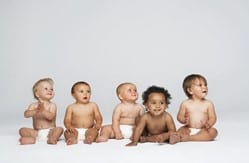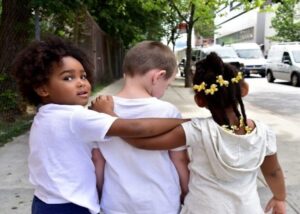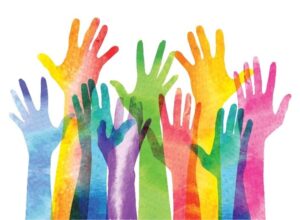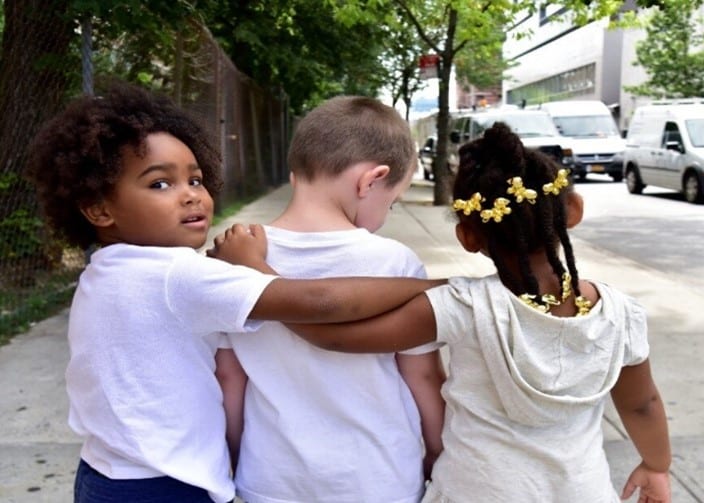by Jenny Rea, Ph.D.
From a very young age, children (even babies) recognize differences. The ability to differentiate has been extensively studied across areas of development. As early as birth, babies can differentiate between male and female caregivers and can differentiate between those who speak their native language and those who do not (Lingras, 2021).
“Children are not born colorblind.” -Sesame Workshop

Used with permission by The Conversation.com
“We know that babies notice physical differences, from skin color to eye shape and hair texture” (SesameWorkshop.org, 2021). For instance, by three months of age, infants have an awareness of race and show preference to a person whose race matches their own (Baxley, 2021 & Lingras, 2021). At six to eight months, infants learn when uncertainty is present by relying on own-race adults.
Such preferences continue over the early years, as children develop their own racial identity by age two. In fact, toddlers use social cues such as body language and facial expressions to make sense of their world. As they watch adults respond to differences in people, toddlers mimic those attitudes and racial biases without us even realizing it (Baxley, 2021).
“Research shows that as young as three, toddlers associate some racial groups with negative traits, and they use these associations to develop their own understanding about the world around them.” -Dr. Traci Baxley
By preschool age, children are becoming much more aware of differences in others such as skin color and hair texture; recognizing how others are the same and different from them. Some children may begin to include or exclude playmates based on race and may associate race with wealth, power, or beauty.
In kindergarten and first grade, children may continue to include and exclude peers based on race and begin to notice that race is often a forbidden topic (Baxley, 2021). At this age, children’s curiosity flourishes. They begin to ask more questions, especially about unsettling news. It is common for a child to say “they’re weird” to someone who looks different from them.

Used with permission by A-B-C.org
Since children make sense of the world around them by gathering clues from their experiences; it is important to begin early, honest, and age-appropriate conversations (Baxley, 2021). You can support children’s natural curiosity by asking and answering questions (even the most difficult ones). Children need to know that it is okay to notice skin color and to talk about race.
“The idea is to make differences normal… and good!” -Dr. Traci Baxley
Military Families and Racial Literacy
Building racial literacy in all children is essential but can be especially valuable to children of military families. On average, a military child moves six to nine times during a school career, which is three times more frequent than non-military families (Ruff & Keim, 2014). Regular relocations do, however, promote greater resilience among military children – the ability to adapt in the face of adversity and the capacity to acclimate to various life transitions and challenges (Mancini et al., 2018).
Military children are also uniquely positioned to develop and engage in more opportunities where they meet, connect, and build lasting relationships with others from various racial, ethnic, and cultural backgrounds. In their willingness to learn new words and understand ideas from others’ perspectives, it is likely that we, as professionals, might be able to learn racial literacy from a military child’s perspective as well.
Racial Literacy is:
- The knowledge, skills, and awareness needed to talk thoughtfully about race and racism. This naturally includes having a rich vocabulary including terms such as race, racism, prejudice, ally, upstander, and so on.
- The ability to identify racism when it happens.
- Having strategies to counter or cope with racism.
- Understanding the role racism plays in society.

Used with permission by MercerCountyEA.org
The process of building racial literacy also means building children’s sense of self and self-worth will look different in each family. Racial literacy is essential to thriving within the world as it is. As professionals, we hold the power to create an antiracist world together. You can help military parents, caregivers and children better understand this complicated, flawed, and often unfair world by talking honestly and directly about race and diversity.
Having conversations about race with the families you serve can be easier than you think. It can start with providing caregivers with teachable moments and simple open-ended questions.
Here are a few racial literacy strategies you, as military family service professionals, can use today!
- Begin with self-reflection and education about topics such as implicit bias, privilege, racial injustice, and racial identity. Consider adding these books to your personal library:
- So You Want to Talk About Race by Ijeoma Oluo
- How to Be an Antiracist by Ibram X. Kendi
- Why are all the Black Kids Sitting Together in the Cafeteria? By Beverly Daniel Tatum
- Seek resources that support individuals who have lived experiences of racial injustice and discrimination, for example:
- “Antiracism Resources” for adults (Flicker & Klein, 2020)
- “Scaffolded Anti-racist Resources” (Stamborski et al., 2020).
- Broaden language related to other aspects of identity. For instance, you may discuss:
- Family structures (for example, “families look different in many ways”),
- Religious clothing (for instance, the scarf Fatima wears on her head is called a hijab. She wears it because it is part of her religion.”), or
- Gender pronouns (such as, “some kids know they are a boy, some kids know they are a girl, some kids don’t feel like either, and some kids feel like both!”)
- Ask caregivers what conversations have occurred regarding race, identity, racism, and even privilege. Be sure to consider racial trauma that may have been experienced or witnessed.
- Teach caregivers how to also self-reflect on racial biases.
- Educate caregivers to watch for opportunities to discuss race and racial differences with their child(ren). Check out this resource, “3 Ideas to Support Your Family’s Anti-Racism Journey” for examples!
- Provide examples of ways to expose and frame differences positively as a means to reduce biases.
- Introduce ideas and activities of race and related topics in simple and age-appropriate terms. PBS Kids provides this excellent tool for talking about race with kids.
- Highlight resilience and cultural strengths. It is important for all children to understand the positives of different cultures and not just the struggles.
Additional Resources to Help:
For more OneOp resources related to racism and diversity, we suggest you check out:
-
- “Talking to Children about Racism” blog post written by Dr. Katherine Lingras
- The six sessions of the 2018 OneOp Virtual Conference Cultural Competency: Awareness, Action, and Advocacy that addresses topics including privilege and power, race, equity, dis/ability, intersectionality, authentic dialogue, sexual orientation, gender expression, and health disparities.
- The five-part podcast series, Moving Toward Inclusive Practice with Dr. Anne Phibbs, can help you on your journey toward a more inclusive, culturally-informed way of working.
- Register today to attend the upcoming free webinar on July 27th entitled, “Coming Together with Sesame Street: Resources for Racial Justice.” You will learn new resources from your friends at Sesame Street in building racial literacy with caregivers and children.
- Be sure to also keep an eye out for a blog written by our team that will provide a list of children’s books on social and racial justice!
This article was written by Jenny Rea, a doctorate in Family Social Science, military spouse, and mom to three kiddos under four. Jenny consults with the OneOp Family Transitions team to support professional development for military family service providers. You may find more blogs, podcasts, and webinars from Family Transitions. We invite you to engage with Family Transitions on Twitter @MFLNFT and with OneOp on Facebook @MilitaryFamilies.
References
- Baxley, T. (2021). Never too young: Ages and stages of racial understanding. Retrieved from https://sesamestreetincommunities.org/activities/never-too-young-ages-and-stages-of-racial-understanding/
- Lingras, K. A. (2021). Talking with children about race and racism. Journal of Health Service Psychology, online first (1-8). doi: 10.1007/s42843-021-00027-4 *This article provides developmentally appropriate explanations of racial literacy.
- Mancini, J. A., O’Neal, C. W., Martin, J. A., & Bowen, G. L. (2018). Community social organization and military families: Theoretical perspectives on transitions, contexts, and resilience. Journal of Family Theory & Review, 10(3), 550-565.
- Ruff, S. B., & Keim, M. A. (2014). Revolving doors: The impact of multiple school transitions on military children. Professional Counselor, 4(2), 103-113.
- org (2021). The ABCs of Racial Literacy. Retrieved from https://www.sesameworkshop.org/what-we-do/racial-justice?_ga=2.2542646.709272138.1621185365-806485381.1618324912















